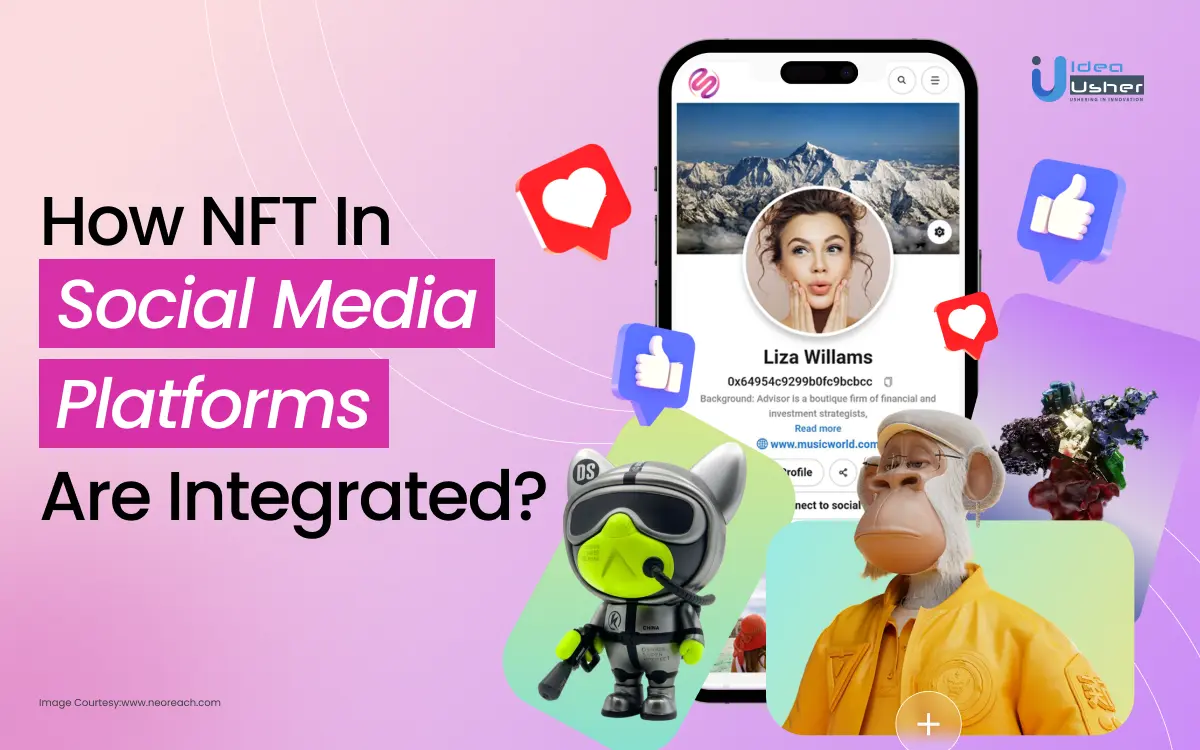
NFTs have created new opportunities for digital ownership and raised great interest among sports fans, musicians, and the art world.
This surge has extended to social media platforms, where NFTs are seamlessly integrated to create fresh revenue streams and enhance user experiences. The evolution of social media from the early days of MySpace and Facebook has paved the way for a transformative relationship between NFTs and these platforms.
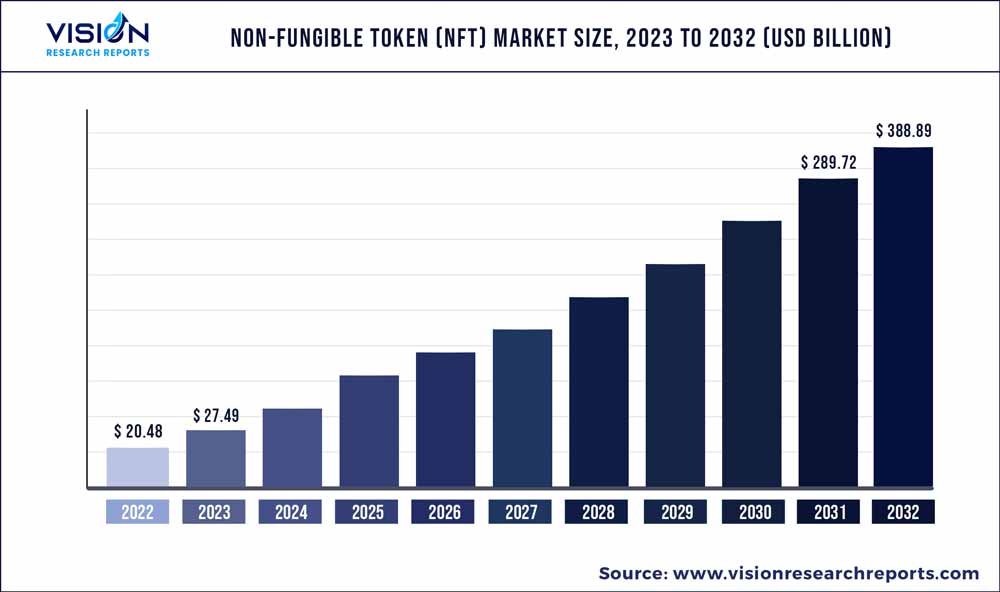
Source: Vision Research Reports
NFTs are now making a significant impact on social media platforms, reshaping the landscape by offering innovative ways to foster engagement, widen user bases, and create novel revenue streams.
Social media serves as hubs for communication, entertainment, and information sharing, with NFTs playing a pivotal role in boosting engagement, broadening consumer bases, and generating revenue for content creators and platform owners.
In this blog, we will explore the diverse aspects of NFT integration in social media platforms, examining its impact on daily life and uncovering the benefits and challenges associated with this technological integration.
- What Are NFTs?
- How Does Social Media NFT Integration Work?
- How NFTs Are Used In Social Media Platforms?
- Business Benefits Of NFT In Social Media Platforms
- Use Cases of NFTs in Social Media
- Examples Of NFT Integration In Social Media Platforms
- How Can NFT In Social Media Benefit Users?
- Who Benefits From Social Media Platforms Based On NFT?
- How To Integrate NFT In Social Media Platform?
- Conclusion
- How Idea Usher Can Help With NFT Integration?
- FAQ
What Are NFTs?
Non-fungible tokens (NFTs) have emerged as a revolutionary concept in the digital world, serving as unique and indivisible certificates of ownership for various online assets. These assets encompass a wide range, from digital art and music to tweets, profile pictures, virtual real estate, and more. Unlike traditional cryptocurrencies such as Bitcoin or Ethereum, NFTs are not interchangeable on a one-to-one basis. Each NFT is distinct, representing a specific digital item or content.
One of the key features of NFTs is their ability to establish and verify digital ownership and authenticity using blockchain technology. Blockchain, a decentralized and transparent ledger, ensures the scarcity and uniqueness of each token by providing a secure and unalterable record of ownership. This has implications for creators, enabling them to monetize their digital creations directly and allowing buyers to have verifiable proof of ownership for their unique digital assets.
The popularity of NFTs can be attributed to the growing interest in digital collectibles and the desire for a decentralized and secure way to represent ownership of online content. High-profile sales of rare NFTs, often reaching millions of dollars, have captured mainstream attention and fueled the perception of NFTs as a new frontier in the art and entertainment industry. However, the NFT market has also faced scrutiny, with concerns about environmental impact due to the energy consumption associated with blockchain transactions and potential copyright and intellectual property issues.
As the NFT space continues to evolve, it raises questions about the long-term impact on the art world, digital ownership, and the broader implications for the future of decentralized technologies and online content monetization. Whether NFTs represent a transformative shift or a temporary trend remains a topic of ongoing debate and exploration within the digital and creative communities.
How Does Social Media NFT Integration Work?
Social media NFT integration is a dynamic intersection of blockchain technology and digital content platforms. This transformative synergy enables creating, owning, and trading unique digital assets, fostering a new era of value, authenticity, and engagement within the social media.
1. Connecting Crypto Wallets
At the core of NFT integration within social media is utilizing crypto wallet connectors. Users initiate this process by linking their digital wallets to their social media accounts, establishing a seamless connection that facilitates interaction with NFTs. This linkage is a secure bridge, allowing users to transfer and showcase their NFTs directly within the social platform. By bridging the traditional gap between cryptocurrency wallets and social media accounts, this integration democratizes access to the NFT market, enabling a broader audience to engage with digital assets.
2. Blockchain Validation of NFT Ownership
The credibility and authenticity of NFTs on social media are ensured through blockchain verification. Social media platforms leverage blockchain technology to verify ownership, confirming the legitimacy of NFTs through the decentralized ledger. This process adds an extra layer of trust, as users can transparently validate the origin and ownership of their digital assets. Blockchain verification safeguards against fraudulent activities and establishes a foundation for a trustworthy and secure environment for NFT transactions within the social platform.
3. Custom Smart Contracts for NFT Creation
Social media platforms enhance the user experience by implementing custom smart contracts for NFT and token creation. These contracts define the rules governing interactions with NFTs within the platform, allowing for unique and tailored functionalities. Customization is key, enabling platforms to align NFT features with their specific engagement objectives. By incorporating bespoke smart contracts, social media platforms can craft an environment that resonates with their user base, fostering a more personalized and engaging NFT experience.
4. Syncing NFT Data in the Backend
A crucial aspect of NFT integration involves the backend syncing of data related to NFTs. This process ensures that information such as ownership details, metadata, and transaction history is accurately reflected across databases and servers. The synchronization guarantees that a user’s NFT collection is seamlessly integrated into their social media profile, providing a unified and cohesive digital presence. This backend infrastructure is vital for maintaining the accuracy and consistency of NFT-related data across the entire social media platform.
5. Interactive NFT Profiles
Once NFTs are integrated, users can showcase their digital assets directly on their profiles, transforming these profiles into interactive spaces for self-expression. Features such as likes, comments, and shares can be applied directly to specific NFTs, fostering social engagement around digital collectibles. This interactive element not only promotes user interaction but also enhances the social and communal aspects of NFT ownership, turning individual profiles into dynamic hubs of creative expression and digital asset interaction.
6. Ecosystem Development
NFT integration extends beyond individual profiles, leading to the creation of entire ecosystems within social media platforms. Users within these ecosystems can seamlessly trade, gift, or collaborate on NFT projects directly within the social environment. This holistic approach transforms social media platforms into vibrant communities centered around NFT-related activities and transactions. The interconnected nature of this ecosystem amplifies user engagement, positioning social media not only as a platform for personal expression but also as a central hub for the dynamic world of NFTs.
How NFTs Are Used In Social Media Platforms?
The intersection of Non-Fungible Tokens (NFTs) and social media platforms has ushered in a transformative era, redefining how content creators monetize their work and users engage with digital assets.
1. Integration of NFTs for Content Monetization
Social media platforms are integrating NFTs to empower content creators with new avenues for monetization. By allowing creators to tokenize their content, platforms enable them to sell unique digital assets directly to their audience. This includes digital art, music, videos, and even tweets. NFTs serve as certificates of authenticity and ownership, providing a way for creators to earn revenue beyond traditional methods like advertising or brand partnerships. Social media companies often facilitate the creation and sale of these NFTs, acting as a bridge between creators and their audience, and earning a percentage of the transactions.
2. Exclusive NFT Drops and Limited Editions
To enhance user engagement, social media platforms leverage NFTs through exclusive drops and limited editions. Creators can release special or time-limited NFTs, creating a sense of exclusivity and scarcity. These events often lead to increased user participation, as followers seek to own a piece of unique digital content or participate in virtual events tied to these exclusive releases. Social media companies can promote and host these events, fostering a community-driven approach to content consumption.
3. Blockchain-Based User Data and Targeted Services
NFTs inherently utilize blockchain technology to establish ownership and provenance. This technology allows social media platforms to gather detailed information about user interactions with NFTs. The unique data stored within NFTs, such as ownership history and creator details, can be leveraged to refine targeted services and enhance customer experiences. Social media companies can analyze this data to understand user preferences, tailoring content recommendations, advertisements, and platform features accordingly. This personalized approach improves overall customer satisfaction and engagement.
4. Facilitating NFT Creation and Trading
Social media platforms are exploring ways to become all-encompassing ecosystems for NFTs by offering additional services. This includes facilitating the creation of NFTs directly within the platform, simplifying the process for content creators to tokenize their work. Moreover, these platforms can act as trading marketplaces for NFTs, allowing users to buy, sell, and trade digital assets without relying on external exchanges. This comprehensive approach provides users with a seamless experience, consolidating NFT-related activities within the social media platform and generating additional revenue through transaction fees.
5. Community Building and Virtual Economies
The integration of NFTs in social platforms contributes to the development of virtual economies and strengthens community ties. Creators and fans can engage in a more direct and meaningful way through NFT ownership, fostering a sense of belonging. Social media companies can incentivize community participation by introducing features like social tokens, allowing users to earn and spend tokens within the platform. This creates a symbiotic relationship between the platform, creators, and users, leading to a more vibrant and interconnected social ecosystem.
Business Benefits Of NFT In Social Media Platforms
The fusion of Non-Fungible Tokens (NFTs) with social media platforms marks a paradigm shift, unlocking a myriad of advantages that extend beyond traditional digital interactions.
1. Empowering Users
NFTs empower users on social media by providing genuine ownership and control over their digital creations. Through blockchain technology, the decentralized nature of NFTs ensures that users, rather than platforms, hold the keys to their digital assets. This not only allows users to determine how their content is used but also enhances privacy by putting them in charge of who can access their creations. The transparency and security offered by blockchain make NFTs a powerful tool for users to assert control over their online presence and creative output.
2. Identity Management
NFTs offer a unique solution to identity verification on social media platforms. By tying NFTs to a user’s online identity, platforms can reduce the risks of identity theft and impersonation. Users can showcase their authenticity through NFT-based identity verification, creating a reliable and consistent online presence across various platforms. This not only safeguards users against fraudulent activities but also simplifies the process of identification for fellow users, fostering a more trustworthy online environment.
3. NFT-Driven Content Curation
NFTs introduce a new dimension to feed customization on social media platforms. By incorporating metadata within NFTs, platforms can utilize this information to tailor users’ feeds based on their preferences. Users can employ NFT-powered filters to curate the type of content that appears in their feeds, ensuring a more personalized and enjoyable social media experience. This not only enhances user satisfaction but also provides creators with a more engaged audience, as their content reaches those with a genuine interest.
4. NFT-Enhanced Social Graphs
NFTs linked to a user’s social graph provide a visual representation of connections and interactions within the digital space. These social media NFTs create a transparent network, allowing users to trace the origin and dissemination of content. By visually mapping out relationships between users and their content, social graphs foster a sense of community and authenticity. This feature not only enhances user engagement but also provides a valuable tool for creators to understand the impact and reach of their content across their network.
5. Monetizing Content
NFTs revolutionize content monetization on social media by enabling creators to tokenize their work. This transforms digital content into unique, tradable assets that can be bought and sold. Creators can directly monetize their work without relying solely on platform-based revenue streams. Smart contracts associated with NFTs provide creators with ongoing revenue opportunities, allowing them to earn a percentage of sales each time their digital asset is resold in the secondary market. This opens up new financial possibilities for creators, breaking away from traditional monetization models.
6. Collaborative Content Creation
NFTs offer a groundbreaking approach to collaborative content creation on social media. Multiple creators can contribute to a single NFT, and smart contracts can automatically distribute revenue among collaborators. This streamlined process encourages creators to work together, fostering a sense of shared ownership and mutual benefit. Customizable NFT structures for social media allow for shared ownership, where multiple individuals have a stake in the same digital asset. This collaborative feature not only enhances the diversity and richness of content but also promotes collective success within the creative community.
Use Cases of NFTs in Social Media
Non-Fungible Tokens (NFTs) have revolutionized the digital landscape, extending their influence into the realm of social media. From digital collectibles to decentralized platforms, NFTs are redefining the social media experience in innovative and diverse ways.
1. Digital Collectibles and Fan Engagement
NFTs offer a unique way for social media users to collect and trade digital assets, such as exclusive artworks, GIFs, or even moments from live streams. This can foster a sense of community and engagement as users vie for rare or limited edition digital collectibles related to their favorite influencers or content creators. The ownership and scarcity aspects of NFTs add value to these digital items, making them highly sought after.
2. Tokenized Social Media Content
Content creators can tokenize their posts, tweets, or even entire profiles as NFTs, allowing fans to own a piece of digital history. This creates a direct connection between creators and their audience, as fans can support their favorite content by purchasing and owning the original tokenized versions. This also opens up new monetization opportunities for creators beyond traditional advertising and sponsorship deals.
3. Decentralized Social Media Platforms
NFTs can play a pivotal role in the development of decentralized social media platforms. By tokenizing user-generated content, these platforms can provide users with more control over their data and content. Users may have the ability to sell or license their content directly, with NFTs acting as proof of ownership. This shift towards decentralization aligns with the growing demand for user empowerment and data privacy in social media.
4. Virtual Real Estate and Social Spaces
NFTs can be used to represent ownership of virtual spaces within social media platforms or metaverse environments. Users can buy, sell, and trade virtual real estate using NFTs, creating unique and customizable online environments. This not only fosters creativity but also presents opportunities for businesses and brands to establish a virtual presence, host events, and engage with their audience in novel ways within the digital realm.
5. Tokenized Event Tickets and Experiences
Social media-driven events, such as live streams, concerts, or virtual meet-and-greets, can leverage NFTs as digital tickets. These tokenized tickets grant access to exclusive content, backstage experiences, or limited edition merchandise related to the event. This enhances the overall fan experience, provides additional revenue streams for event organizers, and discourages scalping due to the unique, verifiable nature of NFTs.
6. Social Impact and Charitable Contributions
NFTs can be utilized for charitable causes within social media. Content creators, influencers, and brands can tokenize special editions or collaborations, with a portion of the proceeds going towards charitable initiatives. This transparent and traceable system ensures that contributions reach the intended recipients, fostering a sense of social responsibility and community involvement. NFTs can thus serve as a tool to amplify social impact campaigns and fundraising efforts across various social media platforms.
Examples Of NFT Integration In Social Media Platforms
The integration of Non-Fungible Tokens (NFTs) into social media platforms has marked a transformative evolution in the digital landscape. This innovative convergence has enabled users, content creators, and platforms alike to explore novel ways of expressing creativity, establishing ownership, and engaging in unprecedented forms of digital commerce. Here are a few notable examples.
1. Instagram
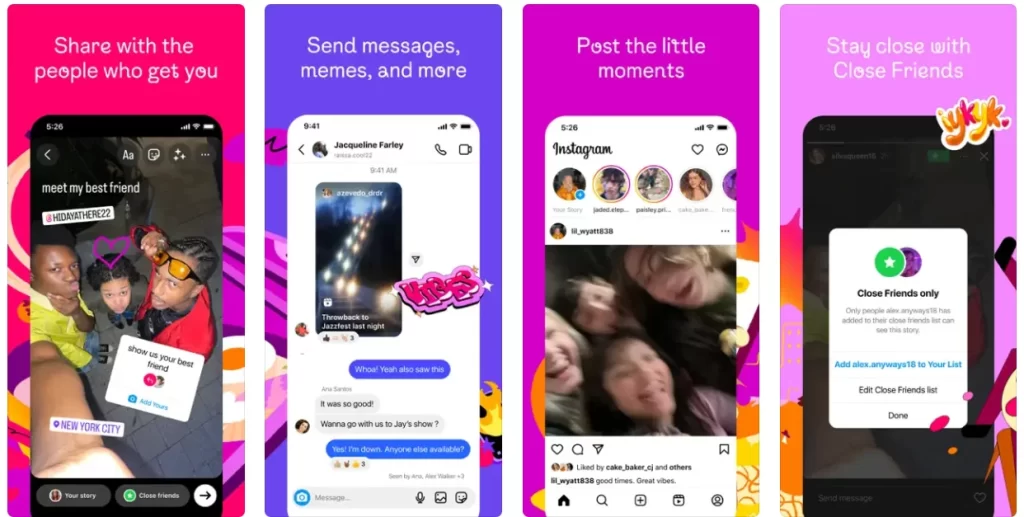
Instagram, renowned for visual storytelling, has ventured into the NFT space through a partnership with Nifty Gateway. This collaboration allows users to exhibit their NFT collections on their Instagram profiles, adding a new dimension to personal expression. The platform is currently testing a “Collectibles” feature, enabling users to highlight their favorite NFTs on their profiles. While still in the experimental phase, this feature holds the promise of bringing NFTs closer to a broader Instagram audience, providing a unique blend of creativity and digital ownership.
2. X
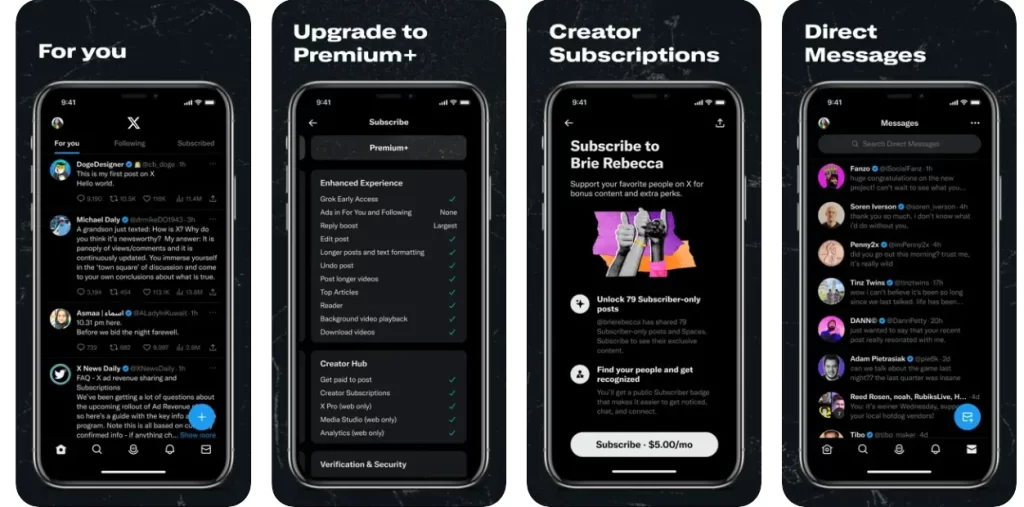
X, formerly Twitter a social media giant, made headlines in March 2021 when its former CEO, Jack Dorsey, auctioned the first tweet as an NFT, fetching a staggering $2.9 million. Building on this success, Twitter has introduced the “Super Follows” feature, enabling creators to monetize their content by offering exclusive experiences to paying followers, including NFTs. Integration with major NFT marketplaces like OpenSea and Rarible allows seamless buying, selling, and showcasing of digital tokens directly on the platform. Twitter’s embrace of NFTs reflects a commitment to transforming social interactions into tangible and tradable digital assets.
3. TikTok
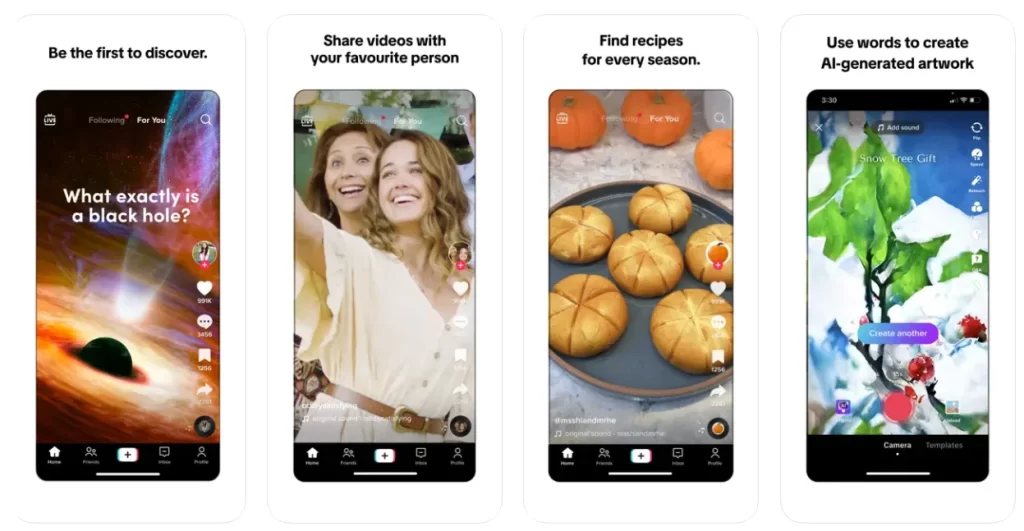
TikTok, known for its short-form video content, is actively exploring the integration of NFTs into its platform. In a strategic move, TikTok disclosed a partnership with an Ethereum Layer 2 solution in September 2021, signaling its intent to launch its inaugural NFT collection. Collaborations with major NFT marketplaces like OpenSea facilitate creators in swiftly selling their tokens within the platform, allowing artists to showcase their digital art to TikTok’s vast user base. This strategic alliance aims to create a new revenue stream and enrich the creative ecosystem on TikTok.
4. Facebook/Meta
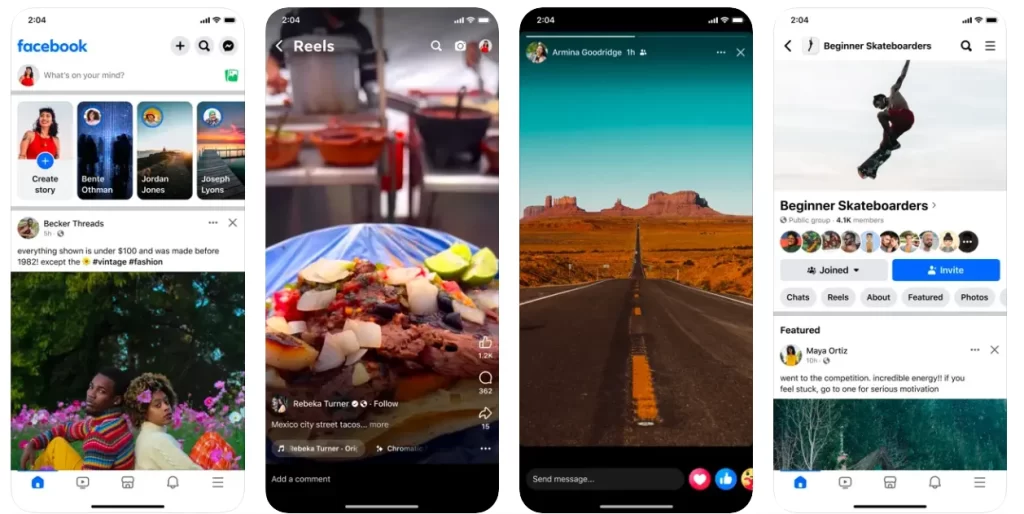
Meta, formerly Facebook, has been actively exploring the integration of NFTs, particularly within its virtual reality platform, Horizon Workrooms. Users can use NFTs to enhance their avatars, signaling a move towards a more immersive and personalized social experience. The acquisition of Giphy, a platform that supports NFTs, opens up possibilities for integrating NFT capabilities into Meta’s extensive product ecosystem. Additionally, Meta is considering allowing users to showcase their NFT collections on their profiles, potentially democratizing access to NFTs within the broader social media landscape.
5. Reddit
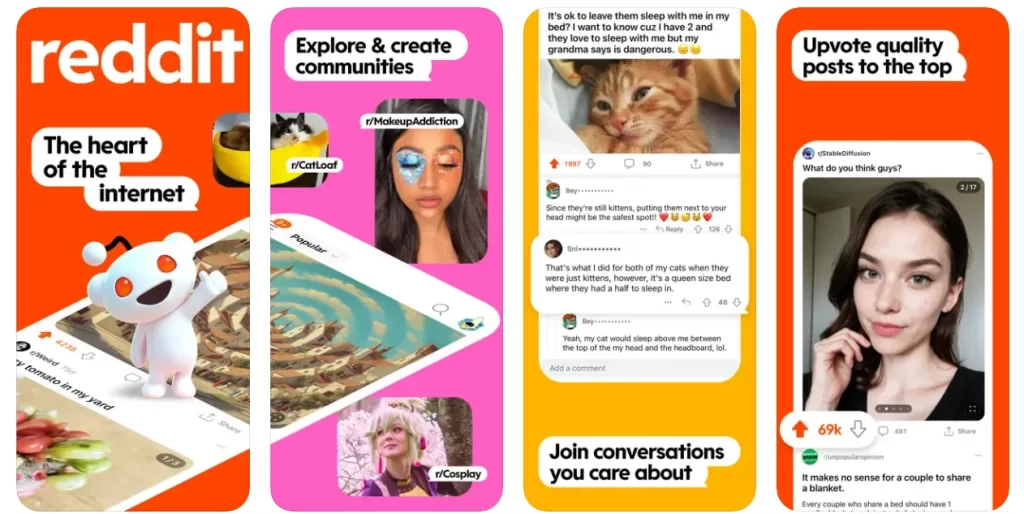
Reddit, a hub for online communities, is making strides in NFT integration. It recently announced a partnership with the Ethereum Foundation for an NFT-based applications competition, showcasing its commitment to innovation in the blockchain space. Reddit is experimenting with NFT-based community points, a system where users can earn rewards for contributions and use them to purchase unique subreddit tokens. The platform’s dedicated marketplace, Reddit NFT, empowers creators to mint and sell their tokens, fostering a vibrant ecosystem of digital ownership within its diverse communities.
6. YouTube
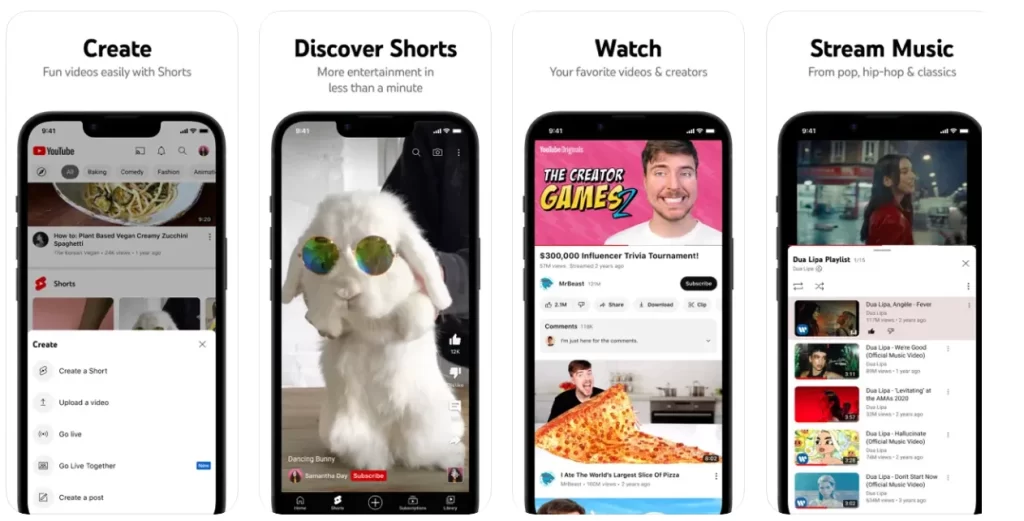
YouTube, a global video-sharing platform, has unveiled plans to incorporate NFTs into its ecosystem, transforming how content creators monetize their work. This innovative move enables creators to offer exclusive items, such as limited-edition videos, unreleased music tracks, or personalized messages, directly to their fans through NFTs. The upcoming “YouTube NFT Marketplace” feature is set to seamlessly integrate with the platform’s existing suite of creator tools, allowing content creators to mint and sell their NFTs directly on YouTube. This integration promises to redefine digital ownership and monetization strategies for creators on the world’s largest video-sharing platform.
How Can NFT In Social Media Benefit Users?
Integrating Non-Fungible Tokens (NFTs) in social media introduces a transformative paradigm, offering users unique and tangible advantages within the digital landscape.
1. Earning through Royalties in Blockchain Social Networks
Blockchain-based social media platforms disrupt the traditional profit-sharing model prevalent in conventional social networks. With NFTs, content creators can directly engage with a global audience, bypassing intermediaries and platform fees. The introduction of royalties in NFTs is a game-changer, allowing creators to earn a percentage of the sale profits each time their work changes hands. This innovative approach not only provides a more equitable revenue distribution model but also incentivizes creators to produce high-quality, sought-after content, benefiting both creators and their audience.
2. Decentralized Autonomy and Control in Social Networks
Decentralized social networks offer users unprecedented autonomy and control over their online presence. In these networks, governed by community consensus rather than centralized authorities, users enjoy censorship resistance, ownership of personal data, and enhanced control over user-generated content. The shift towards decentralized platforms aligns with the growing demand for user empowerment and privacy, creating a more user-centric social media experience.
3. Transforming Social Media Content into Valuable Commodities
NFTs revolutionize the way social media users perceive and monetize their content. By converting digital creations into NFTs, individuals can imbue their intangible creations, such as artworks or photographs, with tangible value. The tokenization process involves linking digital content to crypto-based tokens, enabling ownership verification and creating a market for buying and selling. The perceived value of these NFTs is often driven by scarcity and community consensus, giving creators a novel way to showcase and capitalize on their unique content within the digital realm.
4. Elevated Engagement and Community Interaction through NFTs
NFTs foster a deeper connection between creators and their audience by introducing a direct and transparent form of value exchange. Social media users can engage with creators by purchasing and owning exclusive NFTs, creating a sense of community around shared interests. This heightened engagement goes beyond traditional likes and comments, providing a tangible way for supporters to financially appreciate and participate in the success of their favorite creators. The interactive nature of NFT ownership enhances the overall user experience on social media, creating a more symbiotic relationship between creators and their audience.
5. Preserving Ownership Rights with NFTs
NFTs play a crucial role in addressing copyright concerns for social media users. Through the process of “minting,” content creators can assign NFT values to their digital creations, anchoring the originality and ownership of their work in the NFT source code. This authentication process ensures that creators retain exclusive rights to their content, guarding against unauthorized use and value dilution through digital reproduction. Blockchain’s immutability further strengthens this protection, preventing forgery or replication of digital files and establishing a transparent and secure system for ownership verification.
Who Benefits From Social Media Platforms Based On NFT?
The integration of Non-Fungible Tokens (NFTs) with social media platforms has sparked a transformative wave, reshaping how influencers, digital artists, and brands interact with their audiences.
1. Influencers
NFT-based social media platforms have revolutionized the way influencers engage with their audience. Through these platforms, influencers can establish a direct, peer-to-peer connection with their followers. One significant advantage is the ability to respond creatively to fan requests by turning memorable photos or moments into digital collectibles. This not only enhances fan engagement but also provides influencers with a new revenue stream. The creation and sale of NFTs enable influencers to forge a tangible and unique connection with their audience, fostering a deeper level of loyalty and support.
In addition to monetization, NFTs allow influencers to maintain control over their digital assets and intellectual property. By tokenizing their content, influencers can have greater confidence in the protection of their work and creativity. This empowerment contributes to the sustainability and longevity of their careers in the ever-evolving landscape of social media.
2. Digital Artists
NFT platforms have become a game-changer for digital artists seeking to protect and monetize their original work. These platforms offer a secure and transparent way for artists to copyright and transfer their digital creative assets. By leveraging blockchain technology, artists can ensure the authenticity and ownership of their creations, mitigating concerns related to piracy and unauthorized use.
Direct engagement with audiences is another key benefit for digital artists on NFT platforms. Eliminating intermediaries, artists can establish a direct connection with collectors, fans, and art enthusiasts. This not only fosters a sense of community but also allows artists to receive direct feedback and support for their work. Additionally, the implementation of smart contracts enables artists to receive royalties from secondary sales, providing a continuous revenue stream that extends beyond the initial sale.
3. Brands
NFTs offer brands a unique avenue to explore and capitalize on in both the digital and physical markets. Brands can leverage NFTs to create exclusive and immersive experiences for their audience, fostering a deeper connection with their customer base. Digital art assets, in the form of NFTs, can be utilized in promotional campaigns, enhancing brand visibility and engagement.
One of the significant advantages for brands in the NFT space is the ability to tap into the burgeoning market of digital collectibles. By minting and selling limited edition NFTs, brands can generate additional revenue while providing their audience with unique and coveted items. Moreover, NFTs can prove ownership or authenticity for physical products, adding value to limited-edition merchandise and creating a sense of exclusivity.
Overall, NFT-based social media platforms present brands with innovative ways to increase awareness, drive revenue, and build a more loyal and engaged customer base. The intersection of technology and creativity in the NFT space allows brands to stand out in a crowded digital landscape.
How To Integrate NFT In Social Media Platform?
Integrating NFTs (Non-Fungible Tokens) into social media platforms can be a complex process, as it involves both technical and strategic considerations. Here are steps to follow
1. Define Purpose and Audience
Clearly defining the purpose of integrating NFTs into your social media platform is crucial for crafting a compelling narrative. Whether it’s to empower digital artists, reward content creators, or enhance user engagement, having a well-defined goal provides a strategic direction. Identify your target audience and conduct surveys or focus groups to understand their expectations and preferences regarding NFTs. Consider collaborating with influencers or thought leaders in the NFT space to build excitement and anticipation among potential users.
2. Smart Contract Development
Collaborate closely with experienced blockchain developers to create robust smart contracts. These contracts should not only address the core functionality of NFTs but also consider potential upgrades and scalability. Implement features such as metadata storage, access control, and the ability to customize the NFT attributes to cater to diverse content types. Additionally, explore opportunities to leverage blockchain standards like ERC-721 or ERC-1155 for broader compatibility and interoperability.
3. Blockchain Integration
Selecting the right blockchain is pivotal for the success of your NFT integration. Consider factors like transaction fees, scalability, and the existing NFT ecosystem on the chosen blockchain. Collaborate with blockchain experts to seamlessly integrate your social media platform with the chosen blockchain, ensuring a secure and efficient connection. Explore partnerships with blockchain projects or communities to enhance your platform’s visibility within the broader blockchain space.
4. Wallet Integration
To enhance user adoption, ensure a smooth integration of cryptocurrency wallets within your platform. Support popular wallet providers and offer a secure environment for users to manage their digital assets. Consider implementing multi-chain compatibility to accommodate users with different blockchain preferences. Provide users with incentives, such as exclusive NFT drops or discounts, for connecting and verifying their wallets on your platform.
5. User Onboarding and Education
Design an intuitive onboarding process that guides users through setting up their wallets and understanding the basics of NFTs. Develop comprehensive educational materials, including video tutorials and FAQs, to empower users with the knowledge required to navigate and engage with NFTs on your platform seamlessly. Implement gamified elements in the onboarding process to make learning about NFTs an engaging and enjoyable experience for users.
6. NFT Marketplace Integration
If your social media platform doesn’t have an internal marketplace, collaborate with existing NFT marketplaces or build a dedicated marketplace feature. Ensure a seamless and secure integration, allowing users to explore, trade, and showcase their NFT collections directly within the platform. Consider implementing features such as auctions, bidding mechanisms, and limited edition drops to create a dynamic and engaging marketplace experience for users.
7. Content Tokenization
Clearly define the criteria for tokenizing content as NFTs on your platform. Establish guidelines for digital artists, musicians, and other content creators to tokenize their work. Develop tools that automate the tokenization process, making it accessible to a broader range of users. Consider partnering with creative communities and offering support for collaborative NFT projects to encourage a diverse range of content on your platform.
8. Royalty Distribution System
Implement a transparent and automated royalty distribution system through smart contracts. Clearly outline the percentage distribution for each transaction and ensure that creators receive fair compensation whenever their NFTs are bought or sold within your ecosystem. Consider integrating staking mechanisms or loyalty programs to incentivize long-term engagement and loyalty among content creators and users.
9. Legal Compliance
Engage legal experts to navigate the complex landscape of intellectual property and securities laws related to NFTs. Ensure that your platform complies with regional and international regulations, providing a secure and legally sound environment for users to trade and engage with NFTs. Consider establishing partnerships with legal firms specializing in blockchain and NFTs to stay abreast of evolving regulatory frameworks.
10 .Community Engagement
Foster a vibrant community around NFTs within your social media platform. Implement features such as community forums, virtual events, and collaborative projects to encourage user interaction. Consider integrating social features directly into the NFT experience, enabling users to share and discuss their collections. Leverage decentralized governance models or community-driven decision-making to empower users and enhance the sense of ownership within the NFT ecosystem.
11. Security Measures
Prioritize the implementation of robust security measures to safeguard users’ wallets and NFT assets. Utilize advanced encryption techniques, two-factor authentication, and regular security audits to identify and mitigate potential vulnerabilities proactively. Implement secure key management systems and collaborate with cybersecurity experts to ensure the highest level of protection for user assets and sensitive data.
12. Performance Optimization
Optimize the performance of your NFT platform to ensure a seamless user experience. Implement caching mechanisms, load balancing, and other performance optimization techniques to handle increased traffic during peak periods. Regularly conduct stress testing and scalability assessments to identify potential bottlenecks and ensure the platform’s reliability under various usage scenarios.
Conclusion
The intersection of social media and NFTs marks a transformative digital era, revolutionizing how creators engage with their audience and monetize their work.
Platforms like Twitter and TikTok leverage digital tokens to create innovative opportunities for creators and fan bases. The shift towards NFTs introduces a novel dimension of digital ownership, allowing artists, musicians, and content creators to tokenize their work and establish a direct connection with their supporters.
The evolving landscape allows creators to explore new revenue streams and redefine the traditional structures of content ownership. Looking ahead, the fusion of social media and NFTs may pave the way for a more decentralized digital ecosystem.
Future developments in innovation and integration point to a new age when content producers have more control over their digital work and may establish closer relationships with their audience.
How Idea Usher Can Help With NFT Integration?
Idea Usher emerges as a pivotal partner for business owners seeking seamless NFT integration into their social media strategies. Leveraging our expertise in technology and innovation, we offer a comprehensive suite of services tailored to optimize the incorporation of non-fungible tokens (NFTs) into your social media platforms.
Idea Usher establishes itself as an experienced collaborator, having worked with more than 500 clients, including companies like Gold’s Gym and Honda in addition to flourishing independent firms.
One of our standout offerings is our proficiency in seamlessly integrating Non-Fungible Tokens (NFTs) into social media platforms. By partnering with Idea Usher, business owners can harness the power of NFTs to enhance their social media presence, create exclusive and collectible digital assets, and unlock innovative monetization strategies.
By leveraging our expertise in NFT integration and our track record of successful collaborations, business owners can elevate their social media strategies to unprecedented heights, creating unique and memorable experiences for their audience while staying ahead in the competitive digital landscape.
Contact us today to learn more about how we can help with our NFT development services.
FAQ
Q. What exactly is an NFT and how does it operate?
A. An NFT, or Non-Fungible Token, is a unique type of cryptographic token that represents ownership of a specific digital asset. These tokens are stored on a blockchain, which is a decentralized and secure digital ledger. The uniqueness of NFTs lies in their ability to provide indisputable proof of authenticity and scarcity for digital assets, such as images, videos, or other forms of media. Each NFT is distinct and cannot be exchanged on a one-to-one basis, unlike fungible tokens like cryptocurrencies.
Q. How can NFTs facilitate revenue generation for creators on social media?
A. NFTs empower creators on social media by offering a direct means of monetizing their digital content. Creators can tokenize their work, transforming it into digital collectibles that can be sold to fans and collectors. This opens up new revenue streams, as creators can receive payment in cryptocurrency for each sale. Additionally, NFTs often come with programmable features, allowing creators to earn royalties whenever their tokenized content is resold in the secondary market.
Q. What types of digital content are suitable for NFT conversion?
A. Virtually any form of digital content can be considered for NFT conversion. This includes but is not limited to photos, videos, music, tweets, animated GIFs, digital artwork, and even branded collectibles. The key is to establish a digital asset’s authenticity and scarcity, making it desirable for collectors in the NFT marketplace.
Q. In what ways do decentralized platforms empower participants on social media?
A. Decentralized platforms bring a paradigm shift in social media dynamics by returning control to content creators. Blockchain decentralization ensures increased autonomy, transparency, and resistance to censorship. Participants have greater control over their data and content, reducing the influence and control exerted by centralized entities. This empowerment fosters a more democratic and fair environment for creators and users alike.
Q. Can NFTs help address plagiarism and theft on social platforms?
A. NFTs play a crucial role in combating plagiarism and theft by introducing digital scarcity, provenance tracking, and ownership rights. Each NFT is associated with a specific digital asset, providing an immutable record of its origin. This not only discourages unauthorized use but also establishes a clear chain of ownership, making it easier to enforce intellectual property rights.
Q. Are there existing examples of NFT social networks?
A. Currently, there are pioneering NFT-powered social platforms like Minds and Forest, which specifically cater to artists, photographers, and creators. These platforms integrate blockchain technology to enable users to tokenize and trade their digital creations. As the NFT space evolves, more social networks embracing this technology are expected to emerge, catering to a diverse range of content creators.










Gaurav Patil